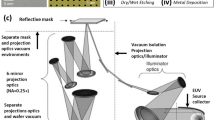Abstract
We present a new method of additive laser technology referred to as STED nanolithography technique. This technique provides a means for fabrication of 3D dielectric and plasmonic composite nanostructures. The new technology is of the utmost interest for the electronics manufacturing industry, in particular, for formation of specific hybrid (metal–dye) nanostructures, which can be utilized as luminescent markers in biology, medicine, criminalistics, and the trade industry. In the present study, we demonstrate the advantages of STED-inspired nanolithography for fabrication of metallic and hybrid nanostructures. The 3D-scanning setup implemented offers the possibility to form both periodic and aperiodic nanostructured arrays. We show the possibility to decrease substantially the lateral size of the lines formed with the use of STED nanolithography as compared to the direct laser writing (DLW) method. The STED nanolithography technique proposed provides a means for synthesizing metallic nanoparticles in the specified points of the volume of the studied object in vivo. In addition, we demonstrate the synthesis of metallic lines by means of STED nanolithography. Moreover, nanometer spatial precision of positioning of the synthesized nanoobjects is achieved. Therefore, it is possible to obtain significant local enhancement of the emission of luminescent markers (surface enhanced luminescence) at any desired point or area of the sample due to plasmonic enhancement of the electromagnetic fields near the surface of metallic nanostructures.
Similar content being viewed by others
References
S. W. Hell and J. Wichmann, Opt. Lett, 19, 780 (1994).
S. W. Hell, Angew. Chem. Int. Ed., 54, 8054 (2015).
J. Fischer and M. Wegener, Opt. Mater. Express, 1, 614 (2011).
R. Wallhofen, J. Katzmann, C. Hrelescu, et al., Opt. Express, 21, 10831 (2013).
Y. Cao, Z. Gan, B. Jia, et al., Opt. Express, 19, 19486 (2011).
S. P. Eliseev, A. E. Korolkov, A. G. Vitukhnovsky, et al., Nanotechnol. Russ., 11, 200 (2016).
J. Fischer and M. Wegener, Laser Photon. Rev., 7, 22 (2013).
T. A. Klar, R. Wollhofen, and J. Jacak, Phys. Scr., T162, 014049 (2014).
M. Schumann, T. Bückmann, N. Gruhler, et al., Light Sci. Appl., 3, e175 (2014).
J. Fischer, G. von Freymann, and M. Wegener, Adv. Mater., 22, 3578 (2010).
L. Zhang, S. Mei, K. Huang, and C. W. Qiu, Adv. Opt. Mater., 4, 818 (2016).
N. Yu, P. Genevet, M. A. Kats, et al., Science, 334, 333 (2011).
M. Khorasaninejad, W. T. Chen, R. C. Devlin, et al., Science, 352, 1190 (2016).
J. P. B. Mueller, N. A. Rubin, R. C. Devlin, et al., Phys. Rev. Lett., 118, 113901 (2017).
C. Rockstuhl, F. Lederer, C. Etrich, et al., Phys. Rev. Lett., 99, 017401 (2007).
G. M. Whitesides and B. Grzybowski, Science, 295, 2418 (2002).
R. M. Erb, H. S. Son, B. Samanta, et al., Nature, 457, 999 (2009).
J. B. Pendry, Phys. Rev. Lett., 85, 3966 (2000).
C. M. Soukoulis and M. Wegener, Nat. Photon., 5, 523 (2011).
P. O. Anikeeva, J. E. Halpert, M. G. Bawendi, and V. Bulović, Nano Lett., 9, 2532 (2009).
A. A. Vashchenko, A. G. Vitukhnovskii, V. S. Lebedev, et al., JETP Lett., 100, 86 (2014).
A. S. Selyukov, A. G. Vitukhnovskii, V. S. Lebedev, et al., J. Exp. Theor. Phys., 120, 185 (2015).
S. W. Hell, Nat. Methods, 6, 24 (2009).
M. Leutenegger, C. Eggeling, and S. W. Hell, Opt. Express, 18, 26417 (2010).
Y. Sivan, Y. Sonnefraud, S. Kéna-Cohen, et al., ACS Nano, 6, 5291 (2012).
Y. Sivan, Appl. Phys. Lett., 101, 021111 (2012).
Y. Sonnefraud, H. G. Sinclair, Y. Sivan, et al., Nano Lett., 14, 4449 (2014).
D. A. Glubokov, V. V. Sychev, A. G. Vitukhnovsky, and A. E. Korol’kov, Quantum Electron., 43, 588 (2013).
D. A. Glubokov, V. V. Sychev, A. G. Vitukhnovskii, and I. V. Taidakov, “Method of manufacturing resistive masks for nanolithography,” RF Patent No. 2510632 (2012).
Author information
Authors and Affiliations
Corresponding author
Rights and permissions
About this article
Cite this article
Vitukhnovsky, A.G., Chubich, D.A., Eliseev, S.P. et al. Advantages of STED-Inspired 3D Direct Laser Writing for Fabrication of Hybrid Nanostructures. J Russ Laser Res 38, 375–382 (2017). https://doi.org/10.1007/s10946-017-9656-2
Received:
Published:
Issue Date:
DOI: https://doi.org/10.1007/s10946-017-9656-2




